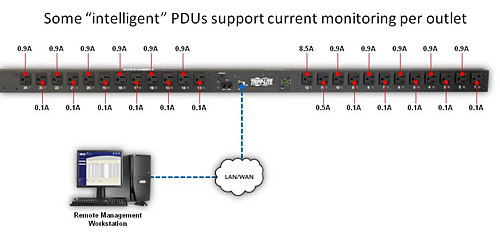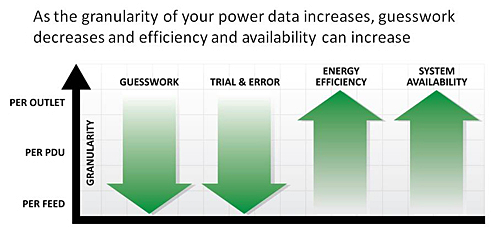Energy efficiency in the data center used to be an afterthought, if it was on the radar at all. But increased processing needs and increasingly power-hungry equipment have made the power bill one of the primary costs of running a data center. The cost of powering a rack server during its operational lifespan can easily exceed the hardware cost of the server, so we don’t just consider the speed of the server anymore—we need to know how much speed we get for each watt that is consumed. Every IT organization is under pressure to manage power more efficiently.
For the purposes of improving energy efficiency, remote current monitoring is the most important PDU capability. Remote current monitoring reduces guesswork about how to improve energy efficiency. Not only can you see current usage in real-time, you can also review data and event logs to monitor trends and improve planning.
Some, but not all, “intelligent” PDUs not only support local and remote current monitoring per load bank or phase, but also per outlet. For example, our 3-Phase Switched PDUs have remote current monitoring per outlet, as well as our Single-Phase Switched PDUs. Because these PDUs give you more precise or granular data, you can get detailed information about how much power a specific device is drawing from a specific outlet.

Outlet level current monitoring is great for determining the operating cost for each individual device on the network and providing more detail about how much power each device pulls. For example, if your PDU is at 95% capacity—it’s time to bring in more electrical capacity. If one of the devices connected to the PDU pulls the majority of the power, it would be really helpful to know which one it is so you can accommodate it better without risking overloading anything. You can also determine how much work you’re getting from the device in relation to the power it consumes to decide whether it would be cost-effective to upgrade to a more energy-efficient device that delivers more work value per watt.
Knowing how much current is being drawn by each PDU allows you to optimize efficiency more easily than if you only know what’s on your monthly bill, but it’s even more helpful to know how much current is being drawn by each outlet. Knowing the current per outlet allows you to perform device-level optimization.

You can also use data logs to optimize energy efficiency, analyze trends and plan capacity in detail, using more granular data to make better decisions.





